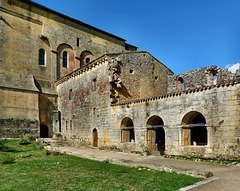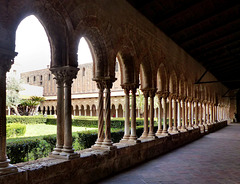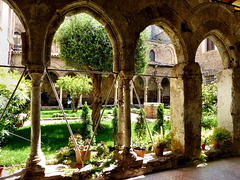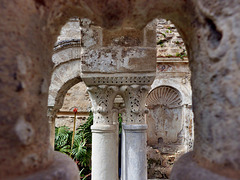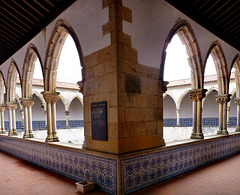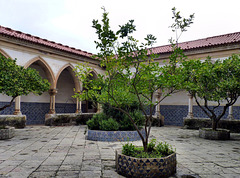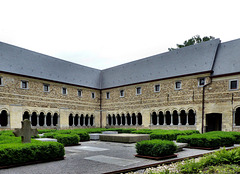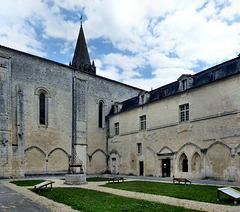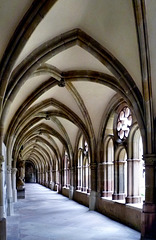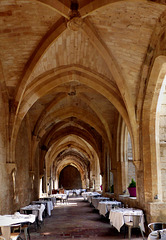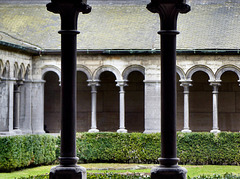
Cloister / Cloître / Kreuzgang
A cloister (from Latin "claustrum") is a covered walk, open gallery running along the walls of buildings and forming a quadrangle. The attachment of a cloister to a cathedral or church indicates that it is (or was) part of a monastic foundation.
Alpirsbach - Kloster Alpirsbach
| |
|
In 1095 three noblemen donated a remote piece of land in the Black Forest to the Order of Saint Benedict in 1095. The monastery, that was founded, was settled by monks from "Kloster St. Blasien". The Bishop of Constance consecrated the first stone oratorio in 1099. In 1101 the monastery was placed under papal protection by Pope Paschal II. Emperor Heinrich V confirmed these rights in 1123. The monastery was strongly influenced by Kloster Hirsau, a centre of the Cluniac Reforms. So the second and third abbots came from Hirsau. The abbey church, a flat-roofed three-aisled basilica with a transept, a choir and side choirs was completed in 1133. It was consecrated three years earlier to Saint Nicholas. The blueprint of the church followed the Cluniac/Hirsau scheme.
The founders had endowed Kloster Alpirsbach with a number of villages when Count Adalbert joined the monastery around 1100, he donated property in the wine-growing Breisgau region. The monastery to prospered and entered an economic boom in the early 15th century. The decline started some decades later and at the end of that century, the abbey was heavily in debt.
In 1522, Alpirsbach's prior Ambrosius Blarer left the monastery after being stripped of his position. Blarer, who had been giving Lutheran sermons at the monastery and had met and befriended the Lutheran reformer Philip Melanchthon, returned to Württemberg in 1534 to become one of Duke Ulrich's chief reformers.
In 1556, Duke Christoph dissolved the monastery. The buildings were used for Protestant seminaries and boarding schools. The Alpirsbach seminary lasted from 1556 to 1595 and taught around 200 students.
Today the former abbey is used for cultural events like concerts and exhibitions. There is as well a very interesting museum.
The Gothic cloister, built 1480 - 1495. Unfortunately, the chapter house was locked. I had my visit badly prepared, so I could not have a guided tour. Next time I will phone in advance.
Alpirsbach - Kloster Alpirsbach
| |
|
In 1095 three noblemen donated a remote piece of land in the Black Forest to the Order of Saint Benedict in 1095. The monastery, that was founded, was settled by monks from "Kloster St. Blasien". The Bishop of Constance consecrated the first stone oratorio in 1099. In 1101 the monastery was placed under papal protection by Pope Paschal II. Emperor Heinrich V confirmed these rights in 1123. The monastery was strongly influenced by Kloster Hirsau, a centre of the Cluniac Reforms. So the second and third abbots came from Hirsau. The abbey church, a flat-roofed three-aisled basilica with a transept, a choir and side choirs was completed in 1133. It was consecrated three years earlier to Saint Nicholas. The blueprint of the church followed the Cluniac/Hirsau scheme.
The founders had endowed Kloster Alpirsbach with a number of villages when Count Adalbert joined the monastery around 1100, he donated property in the wine-growing Breisgau region. The monastery to prospered and entered an economic boom in the early 15th century. The decline started some decades later and at the end of that century, the abbey was heavily in debt.
In 1522, Alpirsbach's prior Ambrosius Blarer left the monastery after being stripped of his position. Blarer, who had been giving Lutheran sermons at the monastery and had met and befriended the Lutheran reformer Philip Melanchthon, returned to Württemberg in 1534 to become one of Duke Ulrich's chief reformers.
In 1556, Duke Christoph dissolved the monastery. The buildings were used for Protestant seminaries and boarding schools. The Alpirsbach seminary lasted from 1556 to 1595 and taught around 200 students.
Today the former abbey is used for cultural events like concerts and exhibitions. There is as well a very interesting museum.
The Gothic cloister, built 1480 - 1495.
Brindisi - Chiesa di San Benedetto
| |
|
Settlers, who did trade with Greece, lived here already during the Bronze Age. After the Punic Wars it became a major center of Roman naval power and maritime trade. After the decline of the Roman Empire Brindisi was conquered by Ostrogoths, and reconquered by the Byzantine Empire in the 6th century. In 674 it was destroyed by the Lombards led by Romuald I of Benevento, It was rebuilt and within the 9th century. It was under Saracen rule from 836 to 868, when it was retaken by the Byantines. In 1070, it was conquered by the Normans, led by Robert Guiskard.
Brindisi flourished under the Staufer and developed into a privileged port for the Holy Land during the period of Crusades. It was an Episcopal See and a new cathedral was constructed, in which the wedding of Norman Prince Roger III of Sicily and Irene Angelina, daughter of the Byzantine Emperor Isaac II Angelos took place.
Emperor Frederick II and Isabella of Brienne embarked from the port of Brindisi in 1228 for the Sixth Crusade.
-
A monastery may have existed here already within the 10th century.
During the 18th century, the old monastery, erected on three sides of the medieval cloister, was abandoned for the construction of the new one. The presence of the Benedictines ended in 1866 when, as a consequence of a suppressive measure, the monks had to leave Brindisi, so it became a parish church.
The medieval cloister.
Saint-Avit-Sénieur
| |
|
|
|
Legends tell, that a young aristocrat named Avitus was a member of the Visigoth army in the battle of Vouillé in 507. When he was a prisoner of the Franks, he converted to Christianity. Liberated he lived as a miraculous hermit, built a chapel and died around 570.
The chapel got destroyed by the Normans, but during the 11th century, a church was erected over his grave and a Benedictine convent was established. When the pilgrimage to Santiago took on, the reputation of Saint Avit let many "pelerins" on the Via Lemovicensis do a detour to visit the relics. So a larger church was built in the 11th and 12th century.
This is the massive, partially fortified church, seen today, next to ruins, that were then the convent of regular canons of Saint Augustine.
The village around and the church burned within the 13th century, but it is unclear whether English, French or Cathar troops did the damage. In 1280 French King Philippe III (le Hardi) ordered the fortification of the town. It did not help much, as later the English destroyed monastery village. During excavations of the cloister stone balls similar to those used for siege machines were found.
In 1577, during the wars of religion, Seigneur of Commarque´s troops entered the monastery, killed or imprisoned the canons, demolished the northwest bell tower and the chevet. The priory never really recovered and in 1695 the chapter of canons is deleted.
The church is about 56 m long and up to 20 m wide. The side walls have round Romanesque arches and in the beginning the ceiling may have been flat. Later in Gothic times the vaults were erected.
Once was the cloister next to the church. Traces of it can still be seen. For a while, the place was used for the communal cemetery.
Monreale - Duomo di Monreale
| |
|
|
|
Sicily, the largest Mediterranean island, has a long history, that starts around 8000 BC, but later there were Phoenician, Carthaginian, Greek and Roman periods. After the Roman Empire had fallen apart the Vandals tried to take over the island but failed. Finally, the Ostrogoths took possession.
Mid of the 6th century Sicily was conquered by troops of the Byzantine Empire. After the advent of Islam, Sicily got attacked by the Arab forces. Raids seeking loot continued until the mid-8th century.
A Muslim army was sent to the island in 827 but met with much resistance. So it took a century to conquer it and even later revolts constantly occurred
In 1038 the Byzantines invaded the island supported by Norman mercenaries, led by Roger. In 1072, after the siege of Palermo, most of Sicily was under Norman control. Roger´s son Roger II raised the status +of the island to a kingdom in 1130. During this period, the Kingdom of Sicily was prosperous and powerful,
The court of Roger II became melting out of culture from Europe and the Middle East. This attracted scholars, scientists, artists, and artisans. Muslims, Jews, Greeks, Lombards, and Normans cooperated and created some extraordinary buildings.
In 1186 the last descendant of Roger, Constance of Sicily married Emperor Henry VI, the second son of Barbarossa. So the crown of Sicily was passed on to the Hohenstaufen Dynasty. Frederick II, the only son of Constance, was crowned King of Sicily at the age of four in 1198. He became "Stupor Mundi", one of the greatest and most cultured men of the Middle Ages.
-
William II of Sicily built from 1172 here a fort-like complex of buildings, which included a cathedral, an archiepiscopal palace, a royal palace and a Benedictine monastery. In 1183 the monastery became the seat of the archdiocese of Monreale. The town then developed around this complex.
According to a legend, William fell asleep while hunting. The Holy Virgin appeared to him in a dream, suggesting him to build a church here. After removing a tree, a treasure was found, whose coins were used to finance the construction. Well, it is much more likely that Monreale was founded in competition with the bishop of Palermo, who had commissioned the large Cathedral of Palermo.
This would explain the vast dimensions and the splendour of the "Duomo di Monreale" and the adjoining cloister, the only structures of the large complex, that survived the times. The cloister was completed around 1200. It measures 47x47 metres. Each side has 26 arches resting on columns.
Monreale - Duomo di Monreale
| |
|
|
Sicily, the largest Mediterranean island, has a long history, that starts around 8000 BC, but later there were Phoenician, Carthaginian, Greek and Roman periods. After the Roman Empire had fallen apart the Vandals tried to take over the island but failed. Finally, the Ostrogoths took possession.
Mid of the 6th century Sicily was conquered by troops of the Byzantine Empire. After the advent of Islam, Sicily got attacked by the Arab forces. Raids seeking loot continued until the mid-8th century.
A Muslim army was sent to the island in 827 but met with much resistance. So it took a century to conquer it and even later revolts constantly occurred
In 1038 the Byzantines invaded the island supported by Norman mercenaries, led by Roger. In 1072, after the siege of Palermo, most of Sicily was under Norman control. Roger´s son Roger II raised the status +of the island to a kingdom in 1130. During this period, the Kingdom of Sicily was prosperous and powerful,
The court of Roger II became melting out of culture from Europe and the Middle East. This attracted scholars, scientists, artists, and artisans. Muslims, Jews, Greeks, Lombards, and Normans cooperated and created some extraordinary buildings.
In 1186 the last descendant of Roger, Constance of Sicily married Emperor Henry VI, the second son of Barbarossa. So the crown of Sicily was passed on to the Hohenstaufen Dynasty. Frederick II, the only son of Constance, was crowned King of Sicily at the age of four in 1198. He became "Stupor Mundi", one of the greatest and most cultured men of the Middle Ages.
-
William II of Sicily built from 1172 here a fort-like complex of buildings, which included a cathedral, an archiepiscopal palace, a royal palace and a Benedictine monastery. In 1183 the monastery became the seat of the archdiocese of Monreale. The town then developed around this complex.
According to a legend, William fell asleep while hunting. The Holy Virgin appeared to him in a dream, suggesting him to build a church here. After removing a tree, a treasure was found, whose coins were used to finance the construction. Well, it is much more likely that Monreale was founded in competition with the bishop of Palermo, who had commissioned the large Cathedral of Palermo.
This would explain the vast dimensions and the splendour of the "Duomo di Monreale" (= "Cattedrale di Santa Maria Nuova"), that with the cloister, seen here from the cathedral´s roof, is the only building that survived the times. The cloister was completed around 1200. It measures 47x47 metres. Each side has 26 arches resting on columns.
Palermo - La Magione
| |
|
|
Sicily, the largest Mediterranean island, has a long history, that starts around 8000 BC, but later there were Phoenician, Carthaginian, Greek and Roman periods. After the Roman Empire had fallen apart the Vandals tried to take over the island but failed. Finally, the Ostrogoths took possession.
Mid of the 6th century Sicily was conquered by troops of the Byzantine Empire. After the advent of Islam, Sicily got attacked by the Arab forces. Raids seeking loot continued until the mid-8th century.
A Muslim army was sent to the island in 827 but met with much resistance. So it took a century to conquer it and even later revolts constantly occurred
In 1038 the Byzantines invaded the island supported by Norman mercenaries, led by Roger. In 1072, after the siege of Palermo, most of Sicily was under Norman control. Roger´s son Roger II raised the status +of the island to a kingdom in 1130. During this period, the Kingdom of Sicily was prosperous and powerful,
The court of Roger II became melting out of culture from Europe and the Middle East. This attracted scholars, scientists, artists, and artisans. Muslims, Jews, Greeks, Lombards, and Normans cooperated and created some extraordinary buildings.
In 1186 the last descendant of Roger, Constance of Sicily married Emperor Henry VI, the second son of Barbarossa. So the crown of Sicily was passed on to the Hohenstaufen Dynasty. Frederick II, the only son of Constance, was crowned King of Sicily at the age of four in 1198. He became "Stupor Mundi", one of the greatest and most cultured men of the Middle Ages.
Palermo, founded in 734 BC by the Phoenicians, became a possession of Carthage and later was part of the Roman Empire. From 831 to 1072 the city was under Arab rule. Following the Norman conquest, Palermo became the capital of a new Kingdom of Sicily and the capital of the Holy Roman Empire under Emperor Frederick II and King Conrad IV.
"Santissima Trinità della Magione" (= "La Magione") was one of the last churches built under Normannic rule.
Foundation took place 1140/50 by Matthew of Ajello, William II of Sicily´s chancellor. It was completed in 1192 by Matthew´s son Archbishop Nikolaus of Salerno. Built on the place of an older mosque it was entrusted the Cistercians und was used as a burial place. Tancred of Sicily and his son Roger III of Sicily were buried in this church.
In 1197, after Emperor Henry VI, husband of Constance daughter and heiress of King Roger II of Sicily, had taken over the kingdom the church and the adjoined monastery were given to the Teutonic Knights.
The church got altered a couple of times, but the restoration of the late 12th and early 20th century "cleaned" the structure from baroque and classisistic addons. Severely damaged during WWII the church another restoration was realized.
Adjoining the church is the cloister of the former monastery. Some parts of this cloister are crumbling.
Palermo - San Giovanni degli Eremiti
| |
|
|
|
Sicily, the largest Mediterranean island, has a long history, that starts around 8000 BC, but later there were Phoenician, Carthaginian, Greek and Roman periods. After the Roman Empire had fallen apart the Vandals tried to take over the island but failed. Finally, the Ostrogoths took possession.
Mid of the 6th century Sicily was conquered by troops of the Byzantine Empire. After the advent of Islam, Sicily got attacked by the Arab forces. Raids seeking loot continued until the mid-8th century.
A Muslim army was sent to the island in 827 but met with much resistance. So it took a century to conquer it and even later revolts constantly occurred
In 1038 the Byzantines invaded the island supported by Norman mercenaries, led by Roger. In 1072, after the siege of Palermo, most of Sicily was under Norman control. Roger´s son Roger II raised the status of the island to a kingdom in 1130. During this period, the Kingdom of Sicily was prosperous and powerful,
The court of Roger II became melting out of culture from Europe and the Middle East. This attracted scholars, scientists, artists, and artisans. Muslims, Jews, Greeks, Lombards, and Normans cooperated and created some extraordinary buildings.
In 1186 the last descendant of Roger, Constance of Sicily married Emperor Henry VI, the second son of Barbarossa. So the crown of Sicily was passed on to the Hohenstaufen Dynasty. Frederick II, the only son of Constance, was crowned King of Sicily at the age of four in 1198. He became "Stupor Mundi", one of the greatest and most cultured men of the Middle Ages.
Palermo, founded in 734 BC by the Phoenicians, became a possession of Carthage and later was part of the Roman Empire. From 831 to 1072 the city was under Arab rule. Following the Norman conquest, Palermo became the capital of a new Kingdom of Sicily and the capital of the Holy Roman Empire under Emperor Frederick II and King Conrad IV.
"San Giovanni degli Eremiti", located in a lush garden, near the "Palazzo dei Normanni", dates back originally to a 6th century erected here and dedicated to Saint Ermete. After the Islamic conquest, it was converted into a mosque. But when Roger II was in power, he entrusted it to Benedictine monks around 1136.
The church was extensively modified during the following centuries. A 19th century restoration attempted to restore its original medieval appearance.
The cloister and the Arab cistern in the centre of it are the best preserved parts of the ancient monastery. The cloister has small double columns.
Porto - Cathedral
| |
|
|
Porto is with a population of about 250.000 the largest city in Northern Portugal. In "Greater Porto", the metropolitan area, live even more than 1.7 million people.
The historical center of Porto was proclaimed a World Heritage Site by UNESCO in 1996. Port wine is named after Porto, since the cellars of Vila Nova de Gaia on the southern banks of the river Douro are the centers for packaging, transport and export of the fortified wine. Some years ago I had been here for a couple of days before I started the "Camino Portugues" here.
The construction of the dominating Porto Cathedral (Sé do Porto) began around 1100 and was completed more than 2 centuries later. Though it underwent different alterations over the centuries (gothic, baroque), the romanesque structure of the once fortified church is still clearly visible.
The gothic cloister was added end of the 14th century. Stairs lead up onto the flat roof of the cloister. The cathedral´s museum can be entered from here.
Tomar - Convento de Cristo
| |
|
Tomar today is a modern city with a population of about 40.000.
After the conquest of the area from the Moors by Portugal´s first king Afonso Henriques in 1147, the land was granted in 1159 as a fief to the Order of the Knights Templar, who erected the castle/monastery "Convento de Cristo" here, that later became the headquarters of the Order in Portugal.
Gualdim Pais, Grand Master of the Order, granted priviliges to the evolving town already in 1162. After the Order of the Knights Templar was suppressed in 1314 King Dinis was able to transfer the possessions and personnel of the Order in Portugal to a newly created Order of Christ. In the 15th century Henry the Navigator was made the Governor of the Order. He was the central figure in the early days of the European maritime discoveries and maritime expansion, later known as the "Age of Discovery", and he may have used resources and knowledge of the Order to succeed in his enterprises in Africa and in the Atlantic.
In 1492 the Jews were expelled from Spain. Many refugees settled in Tomar, what helped the town to develop. Jews lived here undisturbed for several decades until the Portuguese Inquisition got installed. Many could escape by migrating, but about 1000 were tortured and executed.
Tomar was occupied by the French during the Napoleonic invasions and was liberated by Portuguese and English troops commanded by the Duke of Wellington.
The "Convento de Cristo", that towers over Tomar, has a couple of different cloisters. This one, completed in 1453, is named "Claustro da Lavagem" - "Washing Cloister". Here the lay brothers did their chores - and washed their habits.
Tomar - Convento de Cristo
| |
|
|
Tomar today is a modern city with a population of about 40.000.
After the conquest of the area from the Moors by Portugal´s first king Afonso Henriques in 1147, the land was granted in 1159 as a fief to the Order of the Knights Templar, who erected the castle/monastery "Convento de Cristo" here, that later became the headquarters of the Order in Portugal.
Gualdim Pais, Grand Master of the Order, granted priviliges to the evolving town already in 1162. After the Order of the Knights Templar was suppressed in 1314 King Dinis was able to transfer the possessions and personnel of the Order in Portugal to a newly created Order of Christ. In the 15th century Henry the Navigator was made the Governor of the Order. He was the central figure in the early days of the European maritime discoveries and maritime expansion, later known as the "Age of Discovery", and he may have used resources and knowledge of the Order to succeed in his enterprises in Africa and in the Atlantic.
In 1492 the Jews were expelled from Spain. Many refugees settled in Tomar, what helped the town to develop. Jews lived here undisturbed for several decades until the Portuguese Inquisition got installed. Many could escape by migrating, but about 1000 were tortured and executed.
Tomar was occupied by the French during the Napoleonic invasions and was liberated by Portuguese and English troops commanded by the Duke of Wellington.
The "Convento de Cristo", that towers over Tomar, has a couple of different cloisters. This one, completed in 1453, is named "Claustro da Lavagem" - "Washing Cloister". Here the lay brothers did their chores - and washed their habits.
Tongeren - Onze-Lieve-Vrouwebasiliek
| |
|
|
Tongeren, founded 15BC under the name of "Aduatuca Tungrorum", is the oldest town in Belgium. The Romans set up a military camp, that was later abandoned, - but the settlement, that had grown around the camp developed into an important trading center near the Roman road linking Colonia Claudia Ara Agrippinensium (Cologne) to Bononia (Boulogne-sur-Mer). Though strongly fortified the Franks sacked the town in 275.
The Roman reign endet when the town got destroyed in 451 probably by the Huns. At that time a seat of a bishop existed here already. This see later moved on to Maastricht (595) and finally to Liege (718). In 881 Tongeren was raided and looted by the Normans. The largely destroyed city was rebuilt in the 10th century.
Tongeren prospered but in 1677 Louis XIV’s troops blew up the city walls and burned the town down. It took the town two centuries to recover from this.
Where the Onze-Lieve-Vrouwebasiliek stands now, was the bishopric see with Saint Maternus and Saint Servatius, the first bishops of the diocese founded here. In Carolingian times a collegiate convent existed and a pre-Romanesque church was erected, that later got replaced by a Romanesque structure. This church burned down during a war, fought by the prince-bishop of Liège, the Count of Loon, the Duke of Brabant and the French King.
Following the complete demolition of the burnt church, the construction of the large-scale gothic collegiate and town church began in 1240. It was completed in its present form in the 16th century.
Since some years the basilica´s treasures are displayed in the "Teseum", a museum, located in the building of the former collegiate, that adjoins the church.
From the museum, the visitor is able to enter the cloister. When the massive Gothic choir got built, the older Romanesque cloister was partly demolished. The "new" one was erected a little more east to give room for the choir.
teseum.be/en/
Tongeren - Onze-Lieve-Vrouwebasiliek
| |
|
|
|
Tongeren, founded 15BC under the name of "Aduatuca Tungrorum", is the oldest town in Belgium. The Romans set up a military camp, that was later abandoned, - but the settlement, that had grown around the camp developed into an important trading center near the Roman road linking Colonia Claudia Ara Agrippinensium (Cologne) to Bononia (Boulogne-sur-Mer). Though strongly fortified the Franks sacked the town in 275.
The Roman reign endet when the town got destroyed in 451 probably by the Huns. At that time a seat of a bishop existed here already. This see later moved on to Maastricht (595) and finally to Liege (718). In 881 Tongeren was raided and looted by the Normans. The largely destroyed city was rebuilt in the 10th century.
Tongeren prospered but in 1677 Louis XIV’s troops blew up the city walls and burned the town down. It took the town two centuries to recover from this.
Where the Onze-Lieve-Vrouwebasiliek stands now, was the bishopric see with Saint Maternus and Saint Servatius, the first bishops of the diocese founded here. In Carolingian times a collegiate convent existed and a pre-Romanesque church was erected, that later got replaced by a Romanesque structure. This church burned down during a war, fought by the prince-bishop of Liège, the Count of Loon, the Duke of Brabant and the French King.
Following the complete demolition of the burnt church, the construction of the large-scale gothic collegiate and town church began in 1240. It was completed in its present form in the 16th century.
Since some years the basilica´s treasures are displayed in the "Teseum", a museum, located in the building of the former collegiate, that adjoins the church.
From the museum, the visitor is able to enter the cloister. When the massive Gothic choir got built, the older Romanesque cloister was partly demolished. The "new" one was erected a little more east to give room for the choir.
teseum.be/en/
Bassac - Abbaye Saint-Étienne
| |
|
|
|
The Abbaye Saint-Étienne ("Abbey of Saint Steven") was founded in 1002, the first consecration took place already in 1015. Between 1094 and 1246 the convent was depending from the Abbey of Saint-Jean-d'Angély (50kms northwest). After 1246 the convent a new church and a new cloister was erected.
During the Hundred Years War the abbey was badly damaged by English-Gascognic troops, but got rebuilt later and surrounded by a wall. During the Wars of Religions the abbey was besieged and destroyed by Protestant and later Catholic troops. The reconstruction took a century.
The restauration of the 19th century saved the buildings that since 1947 hosts convent of the "Congrégation des frères missionnaires de Sainte-Thérèse de l'Enfant Jésus".
The former cloister is still visible.
Trier - Cathedral of Trier
| |
|
Founded by the Romans around 30 BC as "Augusta Treverorum", Trier claims (just like Xanten, Cologne, Worms, Speyer...) to be the oldest existing German city.
Trier, the center of a diocese already within the 3rd century, was destroyed by the Alemanni (275), rebuilt under Constantine the Great, who resided in "Augusta Treverorum". Under his the reign Maximin of Trier (329–346), the fifth Bishop here, started the construction of an giant ecclesial ensemble with four basilicas and a baptisterium. This was done on the foundations of a Roman settlement - and had a floorplan about 4 times larger than the Cathedral of today.
The buildings, ruined by the Franks, got rebuilt and destroyed again by the Vikings (Normans) in 882. In 977 Emperor Otto II installed his senior official Egbert of Trier as Bishop. Egbert started a building process, that reused lots of the ruined structures. The result can be seen today. The western apse was consecrated in 1224, but the building continued over the centuries.
Constantine´s mother Helena lived in Trier for quite some time. Saint Ambros of Milan, born in Trier, wrote that Saint Helena travelled to Jerusalem at the age of 76. There she not only discovered the Holy Sepulchre, Golgotha and the True Cross but returned loaded with relics. She brought to Trier the relics of the Apostle Matthias (now in St. Matthias) - and the "Holy Robe". The "Holy Robe" (aka "Heiliger Rock") was first mentioned to be here in 1198, what may have ended a rivalry between the Cathedral in Trier and the Abbey in Pruem (60kms north), as Pepin the Short had given "Jesus´Sandals" to that abbey in 752.
The Gothic cloister, joining the Cathedral and the neighbouring Liebfrauenkirche. The whole area got severely damaged in WWII, one tower of the Cathedral collapsed after being hit, in August 1944. The reconstruction of the episcopal complex, including this cloister, started directly after the war.
Klosterreichenbach - Monastery
| |
|
The Reichenbach Monastery ("Kloster Reichenbach") was founded in 1082 as the first priory of Hirsau Abbey. Abbot Wilhelm of Hirsau sent eight monks from Hirsau, to settle the place. The building of the church must have started immediately as already three years later the church, dedicated to Gregory the Great, got consecrated. It is hard to imagine, that the church seen today, was built within only three years, but it may well be, that the Bishop of Konstanz consecrated, while the work was still in progress.
The priory existed upto the Reformation, when the whole area turned Protestant. Today the church is the parochial Lutheran church of Klosterreichenbach.
Of course the priory had a cloister. Here is the last remaining part of the cloister, now used as a storage room.
Saint-Maximin-la-Sainte-Baume - Couvent Royal
| |
|
The discovery of the tomb, containing the relics of Saint Mary Magdalene, in Saint-Maximin-la-Sainte-Baume in 1279 was a very clever "marketing" plot, that put the pilgrim business in Vezelay to a sudden end.
Charles II of Anjou, King of Naples, founded the Basilique Ste. Marie-Madeleine in 1295. Pope Boniface VIII placed it under the new order of Dominicans.
The basilica was built over the crypt (where the tomb had been discovered) but the works slowed down and the basilica never got completed. Next to the basilica, the Dominicans erected a large convent next, to support the pilgrims. The convent, built around a cloister, existed upto the French Revolution, when the building for a while served as a prison. Since 2002 here is a very agreeable and comfortable hotel.
The hotel´s restaurant "Le Chapitre" is centered around the former chapter room. During the warm summer evenings, it is very pleasant to be seated in the cloister for dinner.
www.couvent-royal.fr/en/
Nivelles - Collégiale Sainte-Gertrude
| |
|
In 640 an abbey was founded here by Iduberga (aka Itta, Ida), wife of Pepin I (aka Pippin the Elder), majordomus under three Merovingian kings and forefather of the Carolingians. After Pepin´s death Iduberga moved into the convent and lived the life of a nun, while her daughter Gertrude became the first abbess here.
The abbey began as a community of nuns. After Irish monks were sent by the (Irish) Abbot Foillan to give support to the nuns, a "double monastary" developed.
For most of the Middle Ages the abbey remained an "Imperial Abbey" and from the 12th century, the community slowly changed as the members then became canonesses regular who came from among the nobility.
The old abbey church, erected from 1000 on and consecrated in 1046, was destroyed by the German Luftwaffe in 1940. After WWII the church was rebuilt to its 11th and 13th centuries architecture.
The church meanwhile is a parish church and what still exists of the fromer convent´s buildings is used by the town administration. Some of the civil servants can see the cloister from the offices. For tourists the cloister was locked, so I could only peep in through the gate.
Jump to top
RSS feed- Latest items - Subscribe to the latest items added to this album
- ipernity © 2007-2024
- Help & Contact
|
Club news
|
About ipernity
|
History |
ipernity Club & Prices |
Guide of good conduct
Donate | Group guidelines | Privacy policy | Terms of use | Statutes | In memoria -
Facebook
Twitter




